A beginner gardener's guide step by step: how to plant an apple tree in spring
Spring is the most favorable time for gardening. During this period, grafting of fruit trees begins. There is enough time for the rooting of the scion, and even if the procedure fails, it can be repeated in early summer.
How to plant an apple tree in spring step by step following the recommendations of experienced gardeners, read the article.
The content of the article
When is it better to plant an apple tree
The most favorable period is spring. Grafting with cuttings begins in March - April. The apple tree is grafted with buds or eyes in April - early May.
The best period is when the buds have not yet blossomed, but sap flow has already begun. The procedure is performed on a cool, cloudy day.
Benefits of spring grafting:
- the ability to repeat the procedure in the summer, without wasting time until next spring, if the scions have not taken root for a number of reasons;
- elimination of cultural defects;
- correction of underdeveloped boles;
- restoration of a one-sided crown;
- reanimation of damaged trees;
- breeding hybrid and dwarf varieties;
- increased plant immunity;
- preservation of taste and external characteristics of the variety.

Auspicious time according to the lunar calendar
Grafting of fruit trees is performed on the growing moon. This improves varietal qualities and increases crop endurance. Gardeners recommend carrying out the procedure on fruit days, closer to the full moon, when the moon is in Aries, Leo and Taurus. The growing moon directs the sap and forces of the plant into a new shoot, which helps to take root faster.
Apple grafting calendar for 2020:
- March - 1-4, 6, 8, 26, 29;
- April - 2, 5, 7, 24, 25, 30;
- May - 1, 2, 6, 15-17, 27, 29.
Apple grafting calendar for 2021:
- March - 4, 12-14;
- April - 1, 3-5, 8, 9, 13, 14, 19, 25, 26, 28;
- May - 2, 5-7, 12-17, 21, 22, 24-26.
Objectives of the procedure
The apple tree is grafted in order to:
- increasing yields;
- replacing an old variety with a new one;
- conducting an experiment and growing several new varieties on an old stock;
- saving space on the site (2 varieties can be grown on one rootstock at once);
- ennoblement of a wild apple tree;
- preservation of a tree damaged by rodents;
- increasing frost resistance of "delicate" varieties;
- growing a dwarf apple tree.
How to prepare an apple tree
Experienced gardeners recommend following the basic rules for grafting apple trees:
- On the lower part of the cutting, an oblique cut 3-4 cm long is made, leaving the surface flat.
- The buds of the cutting should point straight up.
- The contact between the inner bark of the cuttings and the stock should be as dense as possible.
- The graft is placed at a distance of 1-1.5 m above the ground surface.
- Old branches must be kept on the rootstock for better nutrition of the root system.
- Trees with a lateral crown are grafted in several stages, distributing them over 2-3 years.
- The rootstock should have a higher frost resistance than the scion.
- Trees with low frost resistance, damaged bark and wood should not be grafted.
- It is not recommended to plant the graft too deeply into the crevice, as this will lead to rotting of the graft site.
- After connecting the stock and the scion, the branches are tied and only then covered with a var so that it does not fall on the cuts.
- To get the correct slant cut on the rootstock, it is recommended to practice on softwood.
Rootstock selection

When choosing a stock, gardeners recommend taking into account the timing of ripening and fruiting. This is due to the fact that the coincidence of the vegetation phases and growth rates increase the chance of survival and further development of plants. For example, a combination of winter and summer apple varieties leads to the fact that the first one at the time of ripening feels a clear nutritional deficiency. As a result, the fruits partially ripen and fall off prematurely.
Reference. The best stock for cultivated apple varieties is Antonovka seedlings.
A high-quality stock combines the following qualities:
- maturity;
- strength of growth;
- winter hardiness;
- productivity;
- developed root system.
There are such types of rootstock:
- cultural;
- wild;
- seed;
- vegetative;
- undersized;
- vigorous.
As a stock used:
- young trees;
- wild growth;
- fruiting apple trees with mediocre fruit taste;
- damaged trees;
- forest stumps or wild-grown seedlings.
It is not recommended to use adult apple trees over 10 years old as a stock. In such trees, sap flow is weakened, and the risk of unsuccessful vaccination increases significantly.
Harvesting cuttings for grafting

As a scion, one-year sprouts of healthy apple-tree branches no more than 3.5 cm long are used. The lower edge is cut at an angle of 45 °. The cut length should be 3 times the scion diameter.
How to prepare cuttings:
- The procedure is performed in late October - early November.
- With the onset of the first frost, long annual shoots with 3-4 buds are cut from the middle part of the branches.
- The material is tied in bundles and wrapped in a damp cotton cloth or covered with wet sawdust or sand.
The optimum storage temperature is + 2 ° C. Cuttings for grafting are folded in a cellar, basement, refrigerator or under the snow. If the grafting material has started to grow, darkened or covered with mold, it is not used for scion.
Cuttings can be prepared in the spring before the buds swell, if in the fall there was no such opportunity. Before the procedure, the instrument is disinfected with medical alcohol or a strong solution of potassium permanganate to prevent contamination of fresh sections with fungi and bacteria.
The branches are taken out of storage 48 hours before vaccination and left in a warm room to warm up.
It is interesting:
How, when and how to spray apple trees in the spring against pests and diseases
How to properly plant a lemon at home so that it does not hurt and bear fruit
Step-by-step instructions for grafting grapes in autumn
How to plant an apple tree in spring
There are many ways to graft apple trees, just choose 2-3 and try each of them in action.
Budding method
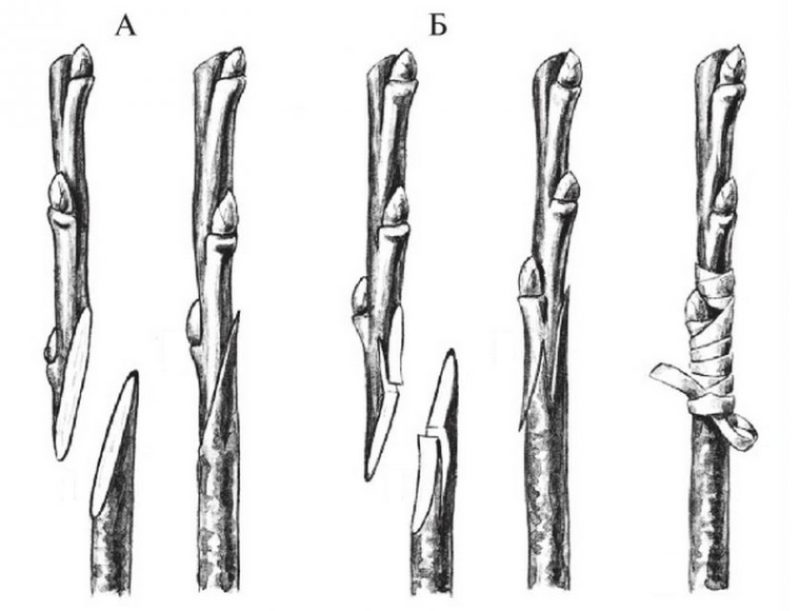
Budding - grafting of young apple trees with a sprouting "eye" (kidney). The procedure is performed in late March - early April, taking into account the weather conditions. The air should warm up to + 7 ... + 10 ° С, and the first leaves should appear on the trees.
A bud with adjacent tissues is cut out of an annual shoot. Insert it into the T-shaped incision on the rootstock trunk.
Into the cleft

This method is used for replanting rootstocks. Skeletal branches should be 2-5 cm in diameter. These usually grow on trees for 3-6 years. The procedure is performed in March - April, when the threat of return frosts has passed, or in July - August, during the second sap flow.
In the process of grafting, a rootstock cutting is inserted into the scion split. If its circumference is 2 times the diameter of the scion, 2-4 rootstocks are fixed in the split. To plant 4 cuttings, a cruciform incision is made on the rootstock.
Copulation method

This method is used if the rootstock and scion have the same thickness. Copulation is practiced for grafting young apple trees with a skeletal branch diameter of 2.5-5 cm.
In the process of copulation, the scion and rootstock are combined into one branch. Success depends on the coincidence of the cambium layers of the two branches. Experienced gardeners recommend using the improved copulation method if the simple experience did not bring the expected result.
With simple copulation, oblique cuts are made on the rootstock and scion, with improved - longitudinal cuts up to 1 cm deep. The graft and rootstock are connected so that the cuts are hooked on each other.
Important! The inoculation procedure should take no more than 1 minute to prevent the cut site from drying out.
For the bark
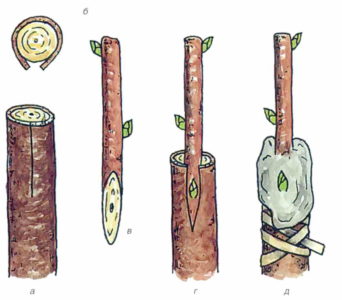
This method is especially popular because it guarantees a high degree of fusion between the scion and rootstock. The stalk is cut with a stump, with which it is fixed to the branch. The cut is made perfectly flat. The bark on the scion is cut vertically and gently pushed back with the tool. The graft is fixed under the bark, the junction is covered with garden varnish and wrapped with electrical tape.
Side cut
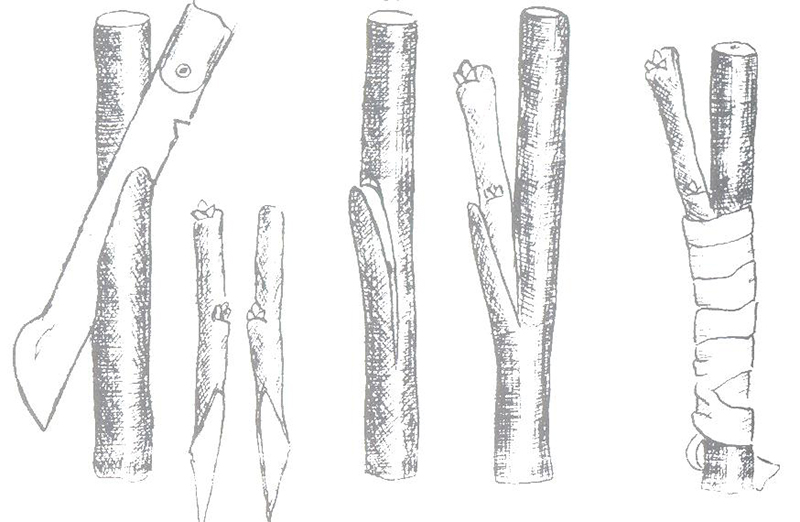
This method resembles grafting into a split, with the difference that the split is done on a cut branch and a stalk is inserted into it. With a side cut, the mother branch is not removed, but the scion and rootstock are attached to each other so that a spear is obtained.
Before grafting the apple tree into the side cut on the handle, make 2 oblique cuts and connect them at the bottom. An incision is made on the stock, it is folded back and the scion is inserted until the cambium is in full contact. The vaccination site is treated with a varnish and wrapped with strips of fabric or electrical tape.
Strapping and further processing
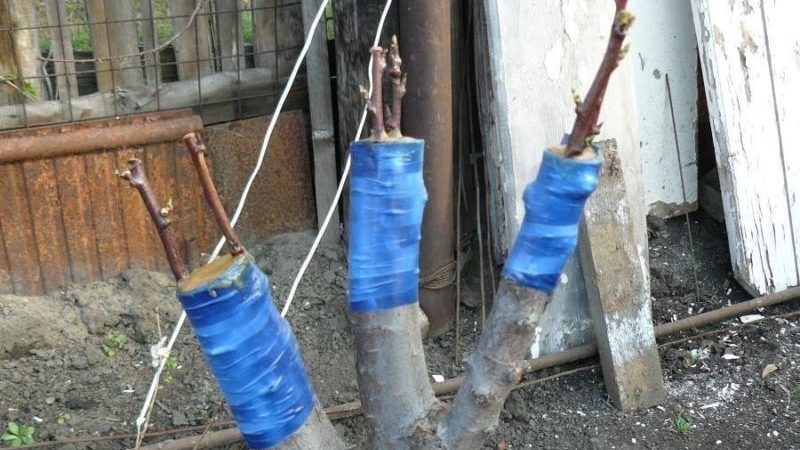
After grafting the apple tree, the joints are lubricated with garden varnish. It is ideal for wound healing. For reliable fixation of the scion, the following materials are used:
- black electrical tape - increases the heating of the junction and stimulates the restoration of plant tissues;
- blue electrical tape - it is more durable than black and reliably fixes the scion to the stock;
- dense plastic wrap - the most convenient to use;
- fabric strips are an environmentally friendly material that reliably fixes the scion and absorbs disinfectants.
To protect the vaccination site from fungal infections and insects, the harness is treated with linseed oil.
Features of vaccination depending on the region
In the southern regions of Russia, it is recommended to use the budding method. The climate here is mild, and the air temperature changes smoothly, without sudden jumps. In the middle lane, budding is used only in the second half of summer - in late July - early August.
The cleft grafting method in the south is practiced in spring and autumn - in September - October. The rest of the methods are used equally often in all regions of the country.
Apple tree care after vaccination
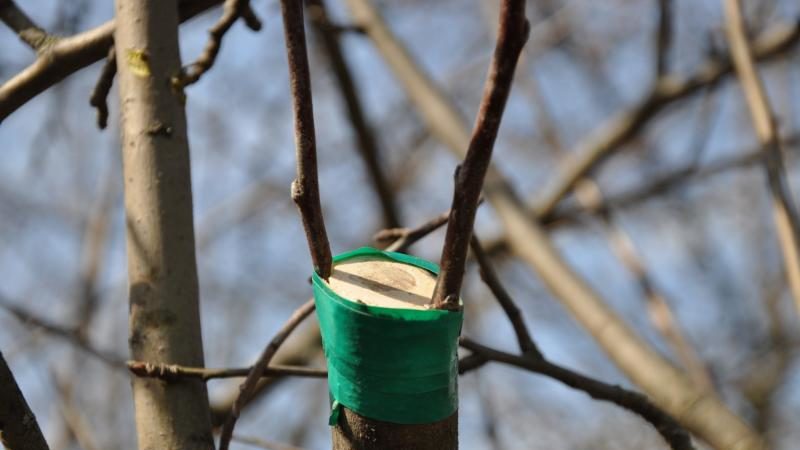
Regardless of the vaccination method, after 10-15 days, the scion is checked for survival: the buds on the cuttings and the place of fixation are examined. In the case of budding, it is determined whether the petiole separates from the flap.
If the inoculation does not take root well, the wound is smeared with garden varnish, and the inoculation is repeated in the summer.
When caring for grafted trees, it is important to loosen the harness in time so that it does not damage the branches. In most cases, the bandage will be removed after 2-3 months.
Shoots appearing below the grafting site are removed with a sharp knife. Otherwise, they will restrain the nutrition of the grafted cuttings. Shoots should not be broken off by hand, as they will grow with renewed vigor.
The grafted apple trees must be protected from direct sunlight, namely the side of the graft must be shaded.
After awakening the kidneys, the first pruning will be performed. If buds and shoots appear on the cuttings, only the strongest of them, which has grown from the upper bud, is left. The lower shoot is shortened, and the lateral ones are cut into a ring to the level of the skeletal branch.
Tying young shoots from grafted cuttings is performed as soon as they reach 20-25 cm in length, and the procedure is repeated when the branches stretch up to 45 cm. In the first 2-3 years after grafting, the connection between the scion and the stock is weak.
Within 2 years after grafting, trees are watered abundantly in dry weather and fed with organic matter and minerals. After grafting, the tree needs intensive care - in this case, plant tissues take root and recover faster.
It is interesting:
A beginner's guide: how to care for roses in spring
Mid-late gooseberry variety Shershnevsky: pros and cons, cultivation features
Conclusion
Spring grafting of apple trees is carried out in order to increase yields, replace the old variety with a new one, grow several varieties on one rootstock, save space on the site, domesticate the wild, reanimate damaged trees, increase frost resistance and plant immunity. The procedure is performed in March - May, focusing on the weather conditions in the regions. The most popular methods of grafting are budding, copulation, in the cleft, behind the bark and in the lateral incision. In the southern regions, the budding method is also used in splitting, in the middle lane, budding is used in the middle of summer.